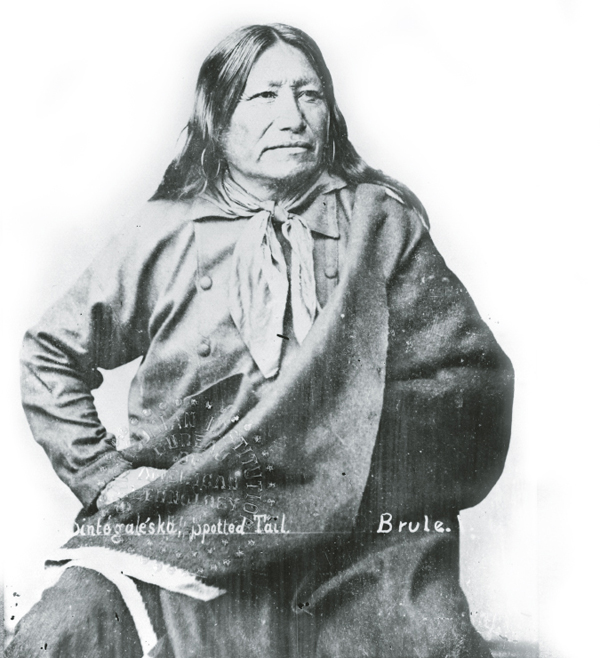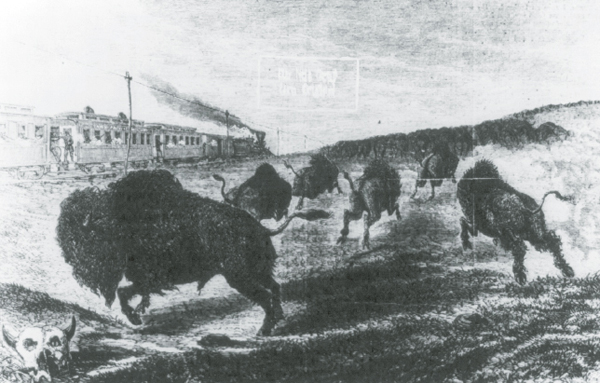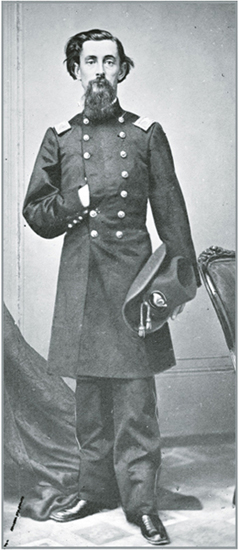
I have two mountains in that country—the Black Hills and the Big Horn Mountain. I want the Great Father to make no roads through them.
—RED CLOUD OF THE OGLALA SIOUX

WHILE THE Indians in the Powder River country were demonstrating their military power, the United States sent a treaty commission to the upper Missouri River. Now that the white man’s Civil War was over, the trickle of white immigration to the West was showing signs of increasing to a flood. What the treaty commissioners wanted was right of passageway for trails, roads, and eventually railroads across the Indian country.
At every Sioux village near the river, the commissioners stopped to meet and talk, or parley, about a new treaty with whatever leaders they could find. Newton Edmunds, recently appointed governor of the Dakota Territory, was the prime mover on this commission. Another member was General Henry Sibley, who had driven the Santee Sioux from Minnesota. Edmunds and Sibley handed out blankets, molasses, crackers, and other presents to the Indians they visited and had no difficulty in persuading their hosts to sign new treaties. They also sent runners into the Black Hills and Powder River country inviting the warrior chiefs to come and sign. But the chiefs were busy fighting General Connor’s invaders, and none responded.
Before the autumn of 1865 ended, the commissioners had completed nine treaties with the Sioux. Government authorities in Washington proclaimed the end of Indian hostilities. At last the Plains Indians were pacified, they said. Never again would there be a need for expensive campaigns such as Connor’s Powder River expedition.

Spotted Tail in an undated photograph. [LOC, USZ62-131515]
Governor Edmunds and the other commission members knew very well that the treaties were meaningless because not one warrior chief had signed them. Although the commissioners forwarded copies to Washington to be ratified by Congress, they continued their efforts to persuade Red Cloud and the other Powder River chiefs to meet with them at a convenient location for further treaty signings. As the Bozeman Trail was the most important route out of Fort Laramie to Montana, military officials at the fort were under heavy pressure to persuade Red Cloud and other war leaders to cease their blockade of the Bozeman Trail and siege of Fort Reno, and to come to Laramie at the earliest possible date.
Colonel Henry Maynadier, the commandant at Fort Laramie, tried to find a trustworthy frontiersman to act as intermediary with Red Cloud. But none was willing to go into the Powder River country so soon after Connor had angered the tribes with his invasion. At last Maynadier decided to employ as messengers some Brulé and Oglala chiefs such as Big Mouth, Big Ribs, Eagle Foot, and Whirlwind, who spent much of their time around the fort. Referred to contemptuously as the “Laramie Loafers,” these trader Indians were actually shrewd entrepreneurs. If a white man wanted a first-rate buffalo robe at a bargain, or if an Indian up on the Tongue River wanted supplies from the fort commissary, the Laramie Loafers arranged exchanges. They would play an important role as munitions suppliers to the Indians during Red Cloud’s war.
During the months of the Moon of Popping Trees (December) and the Moon of Strong Cold (January), Big Mouth and his party spread the news that fine gifts awaited all warrior chiefs if they would come to Fort Laramie and sign new treaties. On January 16, 1866, the messengers returned in company with two bands of Lakota Brulés led by Standing Elk and Swift Bear. The winter had struck these two groups hard. Unable to find enough game and short of shelter, Standing Elk and Swift Bear were eager to sign the treaty and receive clothing and provisions for their cold and hungry people.
“But what about Red Cloud?” Colonel Maynadier wanted to know. “Where were Red Cloud, Man-Afraid-of-His-Horses, Dull Knife—the leaders who had fought Connor’s soldiers?” Big Mouth and the other Laramie Loafers assured him that the warrior chiefs would be there in a short time. They could not be hurried, especially in the Moon of Strong Cold.
There was one important Sioux chief who had decided not to join Red Cloud in the war against the Bluecoats. He was the Brulé chief Sinte Gleska, whom the white man called Spotted Tail. Early in the Moon of the Snowblind (March) a messenger arrived from Spotted Tail informing Colonel Maynadier that the Brulé chief was coming to discuss the treaty. Spotted Tail’s daughter Fleet Foot was very ill, and he hoped the soldiers’ doctor would make her well again. A few days later, when Maynadier heard that Fleet Foot had died en route, he rode out with a company of soldiers and an ambulance to meet the mourning procession of Brulés.
Colonel Maynadier had arranged for a military escort and funeral for Fleet Foot. He hoped that this show of sympathy and respect would help convince Spotted Tail to reopen the Bozeman Trail for the whites. He told Spotted Tail that the Great Father in Washington was sending out a new peace commission in the spring. He wanted Spotted Tail to stay near the fort until the commissioners arrived. It was urgent that the Bozeman Trail be made safe for travel. “I am informed that the travel next spring will be very great,” the colonel said, “to the mines of Idaho and Montana.”
“We think we have been much wronged,” replied Spotted Tail, “and are entitled to compensation for the damage and distress caused by making so many roads through our country, and driving off and destroying the buffalo and game. My heart is very sad, and I cannot talk on business; I will wait and see the counselors the Great Father will send.”
Four days after the funeral for Fleet Foot, Chief Red Cloud, leading a large party of Oglalas, appeared suddenly outside the fort. They stopped first at Spotted Tail’s camp, and the two leaders were enjoying a reunion when Maynadier came out with a soldier escort to conduct both of them to his headquarters with the pomp and ceremony of drums and bugles.
When Maynadier told Red Cloud that the new peace commissioners would not arrive at Fort Laramie for some weeks, the Oglala chief became angry. Big Mouth and the other messengers had told him that if he came in and signed a treaty, he would receive presents. He needed guns, ammunition, and provisions. Maynadier replied that he could issue the visiting Oglalas provisions from the army stores, but he had no authority to distribute guns and ammunition. Red Cloud then wanted to know what the treaty would give his people; they had signed treaties before, and it always seemed that the Indians gave to the white men. This time the white men must give something to the Indians.

An 1867 Harper’s Weekly wood engraving of train passengers shooting buffalo. This was a popular sport for train passengers, who usually left the dead buffalo to rot. [LOC, USZ62-cph-3b08935]
Remembering that the president of the new commission, E. B. Taylor, was in Omaha, Maynadier suggested that Red Cloud send a message to Taylor over the telegraph wires. Red Cloud was suspicious. He did not entirely trust the magic of the talking wires. After some delay, he agreed to go with the colonel to the fort’s telegraph office. Through an interpreter, he dictated a message of peace and friendship to the Great Father’s counselor in Omaha.
Commissioner Taylor’s reply came clicking back: “The Great Father at Washington … wants you all to be his friends and the friends of the white man. If you conclude a treaty of peace, he wishes to make presents to you and your people as a token of his friendship.” A trainload of supplies would arrive at Fort Laramie in early June, and he suggested a treaty-signing ceremony be held then.
Red Cloud was impressed. He also liked Colonel Maynadier’s straightforward manner. He could wait until the Moon When the Grass Is Up (June) for the treaty signing. This would give him time to go back to the Powder River and send out runners to all the scattered bands of Sioux, Cheyenne, and Arapaho. It would also give the Indians time to gather more buffalo hides and beaver skins for trading when they came down to Fort Laramie.
As a goodwill gesture, Maynadier issued small amounts of ammunition to the departing Oglalas, and they rode away in fine good humor. Nothing had been said by Maynadier about opening the Bozeman Trail. Nothing had been said by Red Cloud about Fort Reno, the former Fort Connor, which was still under siege on the Powder. These subjects could be postponed until the treaty council.
Red Cloud did not wait for the grass to come up. In 1866, he returned to Fort Laramie in the Moon When the Ponies Shed (May), and he brought with him his chief lieutenant, Man-Afraid-of-His-Horses, and more than 1,000 Oglalas. Dull Knife brought in several lodges of Cheyennes, and a Brulé named Red Leaf arrived with his band. Together with Spotted Tail’s people and the other Brulés, they formed a great camp along the Platte River.
A few days later, the peace commissioners arrived, and on June 5 the formal proceedings began, with the usual long orations by commission members and the various Indian leaders. Then Red Cloud unexpectedly asked for a few days’ delay while they awaited the arrival of other Tetons who wanted to participate in the discussions. Commissioner Taylor agreed to adjourn the council until June 13.
By a trick of fate, June 13 was the day Colonel Henry B. Carrington and 700 officers and men of the 18th Infantry Regiment reached Fort Laramie. The regiment had marched from Fort Kearney, Nebraska, and was under orders to establish a chain of forts along the Bozeman Trail in preparation for the expected heavy travel to Montana during the summer. Although plans for the expedition had been under way for weeks, none of the Indians invited to attend the treaty signing had been told about this military occupation of the Powder River country.
To avoid friction with the 2,000 Indians camped around Fort Laramie, Carrington halted his regiment four miles east of the post. Standing Elk, one of the Brulé chiefs who had come in during the winter, saw them and rode over to the camp to find out why they were there. After Standing Elk and Carrington had gone through the greeting formalities, Standing Elk asked bluntly, “Where are you going?”
Carrington, known to the Indians as Little White Chief and speaking through his interpreter, replied that he was taking his troops to the Powder River country to guard the road to Montana.
“There is a treaty being made in Laramie with the Sioux that are in the country where you are going,” Standing Elk told him. “You will have to fight the Sioux warriors if you go.”
Carrington said he was going not to make war on the Sioux but only to guard the still-blockaded Bozeman Trail through the Powder River country.
“They will not sell their hunting grounds to the white men for a road,” Standing Elk insisted. “They will not give you the road unless you whip them.” He added quickly that he was a Brulé, that he and Spotted Tail were friends of the white men, but that Red Cloud’s Oglalas and the Minneconjous would fight any white men who came north of the Platte.
Before the next day’s treaty proceedings, every Indian at Fort Laramie knew why the regiment of Bluecoats was there. When Carrington rode into the fort the next morning, Commissioner Taylor decided to introduce him to the chiefs and quietly inform them of what they already knew—that the United States government intended to open a road through the Powder River country regardless of the treaty.

Colonel Henry B. Carrington in a photograph taken between 1860 and 1870. During the Civil War and for a number of years afterward, it was popular for officers to put their right hand inside their uniform jacket, in imitation of French Emperor Napoleon I. [LOC, DIG-cwpb-06857]
Carrington’s first remarks were drowned out by a chorus of disapproving Indian voices. When he resumed speaking, the Indians continued muttering among themselves and began moving about restlessly. Carrington’s interpreter suggested in a whisper that perhaps he should allow the chiefs to speak first.
Man-Afraid-of-His-Horses took the platform. He made it clear that if the soldiers marched into Sioux country, his people would fight them.
Then it was Red Cloud’s turn. His lean figure, clad in a light blanket and moccasins, moved to the center of the platform. His straight black hair, parted in the middle, was draped over his shoulders to his waist. His wide mouth was fixed in a determined slit beneath his hawk-like nose. His eyes flashed as he began scolding the peace commissioners for treating the Indians like children. He accused them of pretending to negotiate for a country while they prepared to take it by conquest.
“The white men have crowded the Indians back year by year,” he said, “until we are forced to live in a small country north of the Platte, and now our last hunting ground, the home of the People, is to be taken from us. Our women and children will starve, but for my part, I prefer to die fighting rather than by starvation…. Great Father sends us presents and wants new road. But [Carrington] goes with soldiers to steal road before Indian says yes or no!”
While the interpreter was still trying to translate the Sioux words into English, the listening Indians became so disorderly that Commissioner Taylor abruptly ended the day’s session. Red Cloud strode past Carrington as if he were not there and continued on across the parade ground toward the Oglala camp. Before the next dawn, the Oglalas were gone from Fort Laramie.
